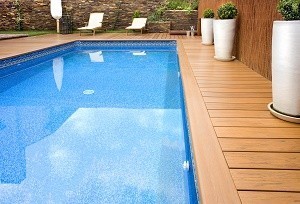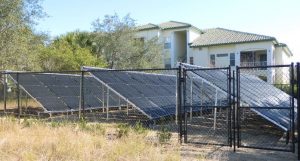The Pros and Cons of Solar Pool Heating Systems
Today we will be discussing the advantages and disadvantages of a rather passive pool heating method: solar heating.
How Can We Help You? Contact Us Today
Welcome back to our series on heating pool methods where I review information from one of my past seminars on the subject. For today’s installment, we will be discussing solar heating systems.
Solar heating systems are very passive. Panels on the roof of the property adjacent to the pool capture solar energy. Water moves past these panels through a connected tube, absorbing between three to five degrees of heat upon each pass. That said, it takes a significant amount of time for the water to become adequately heated. And solar energy is only effective when the sun is shining.
As a result, 70% of heat loss occurs in the overnight hours. This means, when it comes to building up energy, your system must essentially restart each morning. If you are a morning swimmer, you shouldn’t expect your pool to be warm early in the day when using solar heating systems. It essentially takes an entire day just to replenish the heat lost overnight, leaving you with very few hours in the day to enjoy a sufficiently heated pool.
Many people who use a solar heating system will add an additional, supplementary system, but doing so ultimately negates the reasons why someone might opt for a solar system.
On average, a solar pool heating system will produce 1,000 BTUs per square foot of panel per day. So, you will need a lot of panels. This is certainly something to consider before investing in a solar panel.
“
It essentially takes an entire day just to replenish
the heat lost overnight, leaving you with very few hours
in the day to enjoy a sufficiently heated pool.
”
Beyond that, this heating method offers limited effectiveness during winter months when the days are shorter, the sun is lower in the sky, and the air tends to be cool.
There are, of course, benefits to the solar heating method. Two examples I have already mentioned are low operating cost and limited environmental impact, but there is also the fact that this method can work to cool pools down in the summer.
Yet, there are also a number of disadvantages to keep in mind. Low heat output during pool heating season and a large physical installation footprint are just two examples.
If you have any other questions or would like more information, feel free to give me a call or send me an email. I would love to speak with you.

 integrity promised with solar.
integrity promised with solar. Solar is often regarded as the top green technology for heating and cooling pools. When considering what system to install for your pool heating needs, it is crucial to consider all factors of Solar.
Solar is often regarded as the top green technology for heating and cooling pools. When considering what system to install for your pool heating needs, it is crucial to consider all factors of Solar.